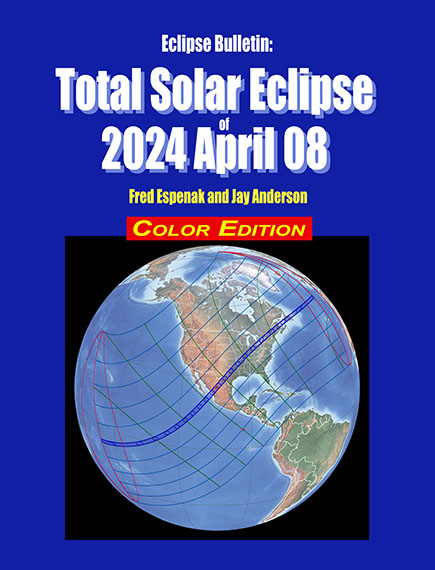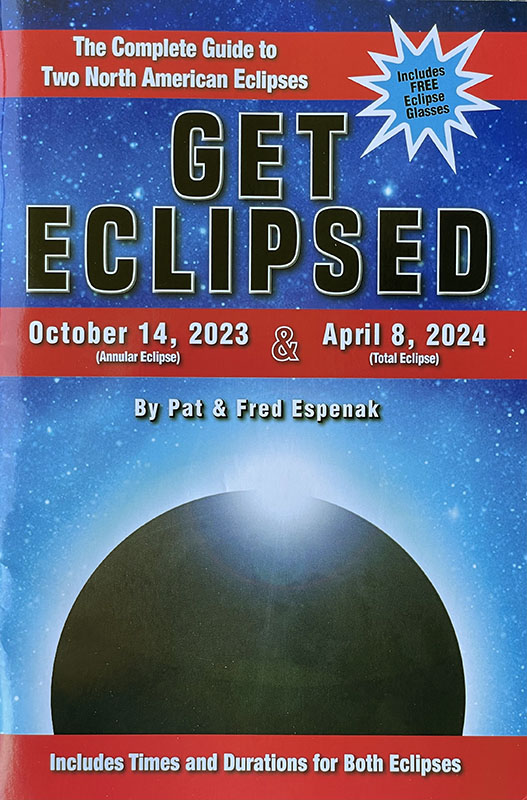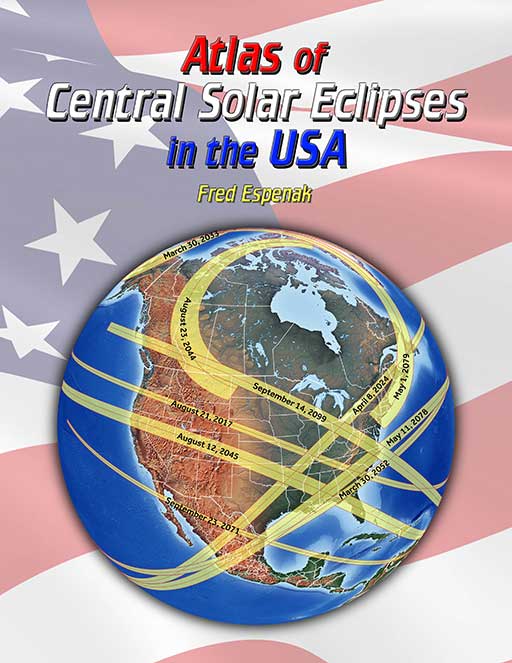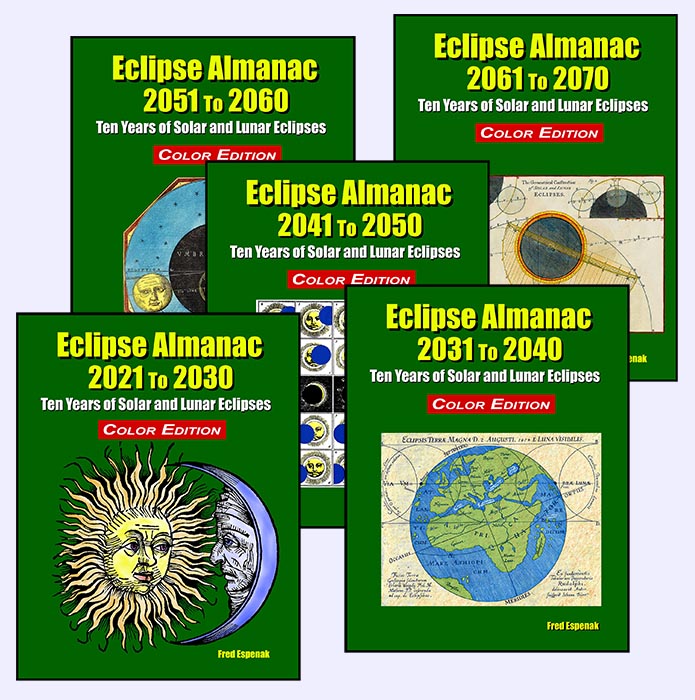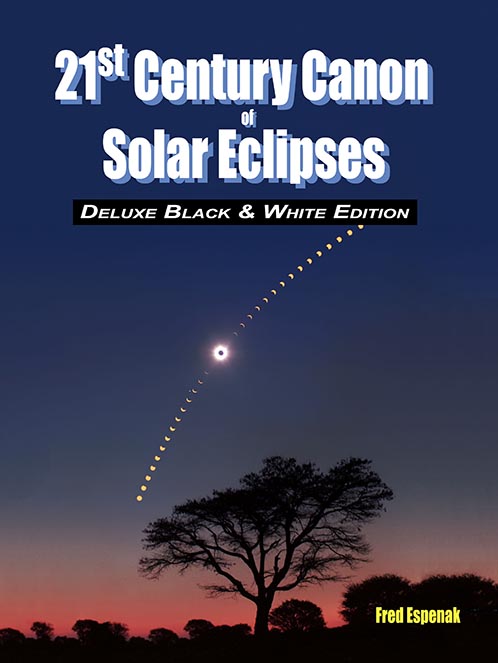Observing Solar Eclipses Safely
Adapted from 'Totality: The Great American Eclipses of 2017 and 2024'

2017 Total Solar Eclipse
This sequence shows the entire eclipse from start to finish.
(click to see more photos)
WARNING!
-
Permanent eye damage can result from looking at the disk of the Sun directly, or through a camera viewfinder, or with binoculars or a telescope even when only a thin crescent of the Sun or Baily's Beads remain.
The 1 percent of the Sun's surface still visible is about 10,000 times brighter than the full moon.
Staring at the Sun under such circumstances is like using a magnifying glass to focus sunlight onto tinder.
The retina is delicate and irreplaceable.
There is little or nothing a retinal surgeon will be able to do to help you.
Never look at the Sun outside of the total phase of an eclipse unless you have adequate eye protection.
Once the Sun is entirely eclipsed, however, its bright surface is hidden from view and it is completely safe to look directly at the totally eclipsed Sun without any filters. In fact, it is one of the greatest sights in nature.
There are five basic ways to observe the partial phases of a solar eclipse without damage to your eyes. We will describe each of them below. We'll also explain how to safely watch an eclipse with binoculars or a telescope.
The Pinhole Projection Method
One safe way of enjoying the Sun during a partial eclipse--or anytime--is a "pinhole camera," which allows you to view a projected image of the Sun. There are fancy pinhole cameras you can make out of cardboard boxes, but a perfectly adequate (and portable) version can be made out of two thin but stiff pieces of white cardboard. Punch a small clean pinhole in one piece of cardboard and let the sunlight fall through that hole onto the second piece of cardboard, which serves as a screen, held below it. An inverted image of the Sun is formed. To make the image larger, move the screen farther from the pinhole. To make the image brighter, move the screen closer to the pinhole. Do not make the pinhole wide or you will only have a shaft of sunlight rather than an image of the crescent Sun. Remember, this instrument is used with your back to the Sun. The sunlight passes over your shoulder, through the pinhole, and forms an image on the cardboard screen beneath it. Do not look through the pinhole at the Sun.
Solar Filters
A second technique for viewing the Sun safely is by looking at it directly through a specially designed solar filter. Such filters permit only a miniscule fraction of the Sun's light to pass through them. Advertisements for solar filters may be found in popular astronomy magazines.
One such type of filter is made of an aluminized polyester. Beware, though, that polyester, a plastic, comes in various thicknesses and with various coatings. You need a metal coating to save your eyesight and you need to examine the Polyester for small holes that could allow unfiltered sunlight to reach your eyes and damage them. A good solar filter will allow you to look comfortably at the filament of a high-intensity electric lamp.
A second type of solar filter is made from a black polymer which gives a yellow/orange tint to the Sun which is more pleasing than the bluish color seen with aluminized polyester filters. Either filter type is completely safe provided that it has an optical density of 5.0 or more. This means that only 0.001% of the Sun's light can pass through the filter.
When using any kind of filter, however, do not stare for long periods at the Sun. Look through the filter briefly and then look away. In this way, a tiny hole that you miss is not likely to cause you any harm. You know from your ignorant childhood days that it is possible to glance at the Sun and immediately look away without damaging your eyes. Just remember that your eyes can be damaged without you feeling any pain.
A list of solar filter retailers can be found in Totality, Appendix C . For more information, see: Solar Filters, by B. Ralph Chou. Another excellent reference on safe solar filters, is: B. Ralph Chou: "Solar Filter Safety," Sky & Telescope, volume 95, February 1998, pages 36-40.
Welders' Goggles
Welders' goggles or the filters for welder's goggles with a rating of 14 or higher are safe to use for looking directly at the Sun. They are also relatively inexpensive.
Warning! Do not attempt to use these filters behind a pair of binoculars or telescope (that is, between your eyes and the binoculars or telescope). The magnifying optics of these devices will focus the full power of the Sun onto the welder's filter which could crack and shatter from the intense heat after only a few minutes. If you wish to observe the eclipse with binoculars or a telescope, you must use a specially designed solar filter on the front end (or Sun-side) of the instrument. These filters are discussed in the next section. (2002/09/03)
Camera and Telescope Solar Filters
Many telescope and camera companies provide metal-coated filters that are safe for viewing the Sun. They are more expensive than common Mylar, but observers generally like them better because they are available in various colors, such as a chromium filter through which the Sun looks orange. Through aluminized Mylar, the Sun is blue-gray. As with the Mylar, you can look directly at the Sun through these filters.
Caution: Do not confuse these filters, which are designed to fit over the lens of a camera or the aperture of a telescope, with a so-called solar eyepiece for a telescope. Solar eyepieces are still sometimes sold with small amateur telescopes. They are not safe because of their tendency to absorb heat and crack, allowing the sunlight concentrated by the telescope's full aperture to enter your eye.
Fully Exposed and Developed Black-and-White Film
You can make your own filter out of black-and-white film, but only true black-and-white film (such as Kodak Tri-X or Pan-X). Such films have a layer of silver within them after they are developed. It is this layer of silver that protects your eyes.
To make your own solar filter, proceed as follows. Open up a roll of black-and-white film and expose it to the Sun for a minute. Have it developed to provide you with negatives. Use the negatives for your filter. It is best to use two layers. With this filter, you can look directly at the Sun with safety.
Remember, however, that if you are planning to use black-and-white film as a solar filter, you need to prepare it at least several days in advance.
Caution: Do not use color film or chromogenic black-and-white film (which is actually a color film). Developed color film, no matter how dark, contains only colored dyes, which do not protect your vision. It is the metallic silver that remains in black-and-white film after development that makes it a safe solar filter.
Eye Suicide
Standard or polaroid sunglasses are not solar filters. They may afford some eye relief if you are outside on a bright day, but you would never think of using them to stare at the Sun. So you cannot use sunglasses, even crossed polaroids, to stare at the Sun during the partial phases of an eclipse. They provide little or no eye protection for this purpose.
Observing with Binoculars
Binoculars were astronomy writer George Lovi's favorite instrument for observing total eclipses. Any size will do. He used 7 x 50 (magnification of 7 times with 50-millimeter [2-inch] objective lenses). "Even the best photographs do not do justice to the detail and color of the Sun in eclipse, and especially the very fine structure of the corona, with its exceedingly delicate contrasts that no film can capture the way the eye can." The people who did the best job of capturing the true appearance of the eclipsed Sun, he felt, were the nineteenth-century artists who photographed totality with their eyes and minds and developed their memories on canvas.
For people who plan to use binoculars on an eclipse, Lovi cautioned common sense. Totality can and should be observed without a filter, whether with the eyes alone or with binoculars or telescopes. But the partial phases of the eclipse, right up through the Diamond Ring Effect, must be observed with filters over the objective lenses of the binoculars. Only when the Diamond Ring has faded is it safe to remove the filter. And it is crucial to return to filtered viewing as totality is ending and the western edge of the Moon's silhouette begins to brighten. After all, binoculars are really two small telescopes mounted side by side. If observing the Sun outside of eclipse totality without a filter is quickly damaging to the unaided eyes, it is far quicker and even more damaging to look at even a sliver of the uneclipsed Sun with binoculars that lack a filter.
Observing with a Telescope
Some observers, including astronomy historian Ruth Freitag, prefer to watch the progress of the eclipse through a small portable telescope, which offers stability and is much less tiring to use for extended periods than binoculars. A telescope also provides more detail at higher powers, if this is desired. The solar filter is removed at totality. When she wants to see a wider view of the corona, she switches to the finder scope.
A Final Thought
Just remember, Lovi said, "Don't try to do too much. Look at the eclipse visually. Don't be so busy operating a camera that you don't see the eclipse. And don't set off for the eclipse so burdened down by baggage and equipment that you are tired and stressed and too nervous to enjoy the event."
Astronomer Isabel Martin Lewis also warned of the dangers of too many things to do: "A noted astronomer who had been on a number of eclipse expeditions once remarked that he had never SEEN a total solar eclipse."
-
The information Observing Solar Eclipses Safely appearing above is adapted from
Totality - The Great American Eclipses of 2017 and 2024.
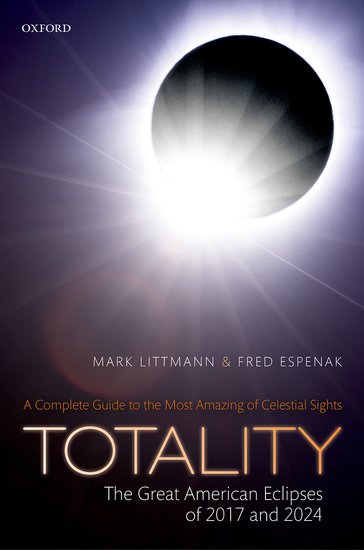
Totality - The Great American Eclipses of 2017 and 2024
©2016 by Mark Littmann and Fred Espenak
Totality - The Great American Eclipses of 2017 and 2024 is a complete guide to the most stunning of celestial sights, total eclipses of the Sun. It focuses on the eclipses of August 21, 2017 and April 8, 2024 that pass across the United States. The U.S. mainland has not experienced a total solar eclipse since 1979. This book provides information, photographs, and illustrations to help the public understand and safely enjoy all aspects of these eclipses including:
- How to observe a total eclipse of the Sun
- How to photograph and video record an eclipse
- Why solar eclipses happen
- The earliest attempts to understand and predict eclipses
- The mythology and folklore of eclipses
- The response of animals to total solar eclipses
- The response of man to total eclipses through time
- How scientists used total eclipses to understand how the Sun works
- How astronomers used a total solar eclipse in 1919 to confirm Einstein's general theory of relativity
- Weather prospects for the 2017 eclipse
- Detailed maps of the path of totality for the 2017 eclipse and the eclipses of 2018 through 2024
- Precise local times for the eclipses of 2017 and 2024 (the next total solar eclipse to visit the U.S.)
- Color and black-and-white photographs, diagrams, and charts to illustrate and explain total solar eclipses
- Global maps of total solar eclipses from 2017 to 2045 and lists of total and annual solar eclipses from 1970 through 2070
Table of Contents
- 1: The Experience of Totality
- 2: The Great Celestial Cover-Up
- 3: Ancient Efforts to Understand
- 4: Eclipses in Mythology
- 5: The Strange Behavior of Man and Beast - Long Ago
- 6: The Sun at Work
- 7: The First Eclipse Chasers
- 8: The Eclipse that Made Einstein Famous
- 9: Observing a Total Eclipse
- 10: Eye Safety During Solar Eclipses
- 11: The Strange Behavior of Man and Beast - Modern Times
- 12: Eclipse Photography
- 13: The All-American Eclipse of 2017
- 14: The Weather Outlook
- 15: When Is the Next One? Total Eclipses: 2018-2023
- 16: Coming Back to America: The Eclipse of 2024
- 17: Epilogue
- Appendix A: Maps for Every Solar Eclipse 2017-2045
- Appendix B: Total, Annular, and Hybrid Eclipses: 2017-2060
- Appendix C: Recent Total, Annular, and Hybrid Eclipses: 1970-2016
- Appendix D: Total Eclipses in the United States: 1492 to 2100
About the Authors
Mark Littmann, Professor, University of Tennessee, Knoxville, and Fred Espenak, Astrophysicist emeritus, NASA - Goddard Space Flight Center.
Mark Littmann has written several popular books about astronomy. Planets Beyond: Discovering the Outer Solar System won the Science Writing Award of the American Institute of Physics. Planet Halley: Once in a Lifetime (Donald K Yeomans, co-author) won the Elliott Montroll Special Award of the New York Academy of Sciences. Reviewers described The Heavens on Fire: The Great Leonid Meteor Storms as a "unique achievement," "altogether satisfying," and "a compelling read." Mark holds an endowed professorship, the Hill Chair of Excellence in Science Writing, at the University of Tennessee where he teaches three different courses in writing about science, technology, medicine, and the environment. He has helped lead expeditions to Canada, Hawaii, Bolivia, Aruba, and Turkey to observe total eclipses.
Fred Espenak is the most widely recognized name in solar eclipses.
He is a scientisit emeritus at NASA's Goddard Space Flight Center, where he founded and runs the NASA Eclipse Home Page <
Also Available!
Road Atlas for the Total Solar Eclipse of 2024
The Road Atlas for the Total Solar Eclipse of 2024 contains a comprehensive series of 26 maps of the path of totality across Mexico, the USA and Canada. The large scale (1 inch ≈ 22 miles) shows both major and minor roads, towns and cities, rivers, parks, and mountains.
Although a partial eclipse will be seen from all of North America, the total phase in which the Moon completely covers the Sun (known as totality) will only be seen from within the 120-mile-wide path of the Moon’s umbral shadow as it sweeps across Mexico, the United States (Texas, Oklahoma, Arkansas, Missouri, Tennessee, Kentucky, Illinois, Indiana, Ohio, Michigan, Pennsylvania, New York, Vermont, New Hampshire, and Maine), and Canada (Ontario, Quebec, New Brunswick, Prince Edward Island, Nova Scotia and Newfoundland).
Armed with this atlas and the latest weather forecasts, the road warrior is ready to chase totality no matter where it takes him/her along the entire path. This mobile strategy offers the highest probability of witnessing the spectacular 2024 total eclipse in clear skies.
For more information visit Road Atlas for the Total Solar Eclipse of 2024 .
Eclipse Bulletin: Total Solar Eclipse of 2024 April 08
The Eclipse Bulletin: Total Solar Eclipse of 2024 April 08 is the complementary publication of the 2024 Road Atlas and is the ultimate guide to this highly anticipated event.
Eleven high resolution maps plot the total eclipse track across Mexico, the USA, and Canada. The large map scale (1 inch ≈ 53 miles) shows hundreds of cities and towns in the path, the location of major roads and highways, and the duration of totality with distance from the central line. Local circumstances tables for hundreds cities the USA, Canada, and Mexico provide times of each phase of the eclipse along with the eclipse magnitude, duration and Sun's altitude. A detailed climatological study identifies areas along the eclipse path where the highest probability of favorable weather may be found.
Finally, comprehensive information is presented about solar filters and how to safely observe the eclipse.
For more information visit Eclipse Bulletin: Total Solar Eclipse of 2024 April 08 .
Get Eclipsed: A Family Guide to Two North American Eclipses
North America will be the scene for two spectacular eclipses of the Sun. On October 14, 2023 , an annular eclipse of the Sun occurs in western USA and Mexico. Six months later, an incomparable total eclipse of the Sun occurs on April 8, 2024 . Its 125-mile wide path crosses Mexico, the USA from Texas to Maine, and eastern Canada.
During both of these events, a partial eclipse of the Sun will be visible from virtually all of North America. The last annular eclipse visible from the USA was in 2012. The last total eclipse visible from the USA was in 2017, and the next one to cross the country won't be until 2044. Don't miss the incredible experience of seeing these celestial wonders!
Get Eclipsed is an easy to read, family friendly, inexpensive eclipse guide for the entire family. It tells you everything you need to know about the upcoming annular and total eclipses of the Sun in 2023 and 2024. And it comes with two pairs of special glasses for safely watching the partial eclipse phases and annularity.
For more information visit Get Eclipsed .
Atlas of Central Solar Eclipses in the USA
The Atlas of Central Solar Eclipses in the USA contains of a series of 499 global maps showing the geographic track of every total and annular solar eclipse across the USA (including Alaska and Hawaii) during the two-thousand-year period 1001 through 3000. It is accompanied by a catalog that lists the major characteristics of each eclipse including its duration and whether it is visible from the lower 48 states, Alaska and/or Hawaii.
A set of 20 detailed maps, each covering a 50-year period and centered on the lower 48 states, shows the path of every total and annular eclipse. The maps include state boundaries and major cities. These maps also cover southern Canada and northern Mexico.
For more information visit Atlas of Central Solar Eclipses in the USA .
Eclipse Almanac
The Eclipse Almanac is a series of five publications. Each one is a concise reference for every eclipse of the Sun and the Moon over a 10-year period. This compendium identifies when and where each of these events will be seen. Particular details about each eclipse are included, as well as a 25-year table looking further into the future.
Section 1 presents solar eclipses including an explanation of why they occur, types of solar eclipses, and the visual appearance of each. Global maps depict the geographic regions of visibility of each of the 22 to 23 solar eclipses.
Section 2 covers lunar eclipses explaning why they occur, the types of lunar eclipses, and the appearance of each. Detailed figures illustrate each of the 22 to 23 lunar eclipses including the Moon's path through Earth's shadows, and a map of the geographic visibility of every eclipse.
Section 3 lists the date and time of the Moon’s phases over the decade.
The five volume Eclipse Almanac series covers the decades from 2021 to 2070.
For more information visit Eclipse Almanac .
21st Century Canon of Solar Eclipses
The 21st Century Canon of Solar Eclipses contains maps and data for all 224 solar eclipses occurring during the 100-year period from 2001 through 2100. The eclipse predictions are based on the Jet Propulsion Lab's DE405 - a computer ephemeris used for calculating high precision coordinates of the Sun and Moon for hundreds of years into the past and future.
Section 1 of the Canon presents the fundamentals about solar eclipses. Section 2 discusses the eclipse the predictions, the constants used. A statistical analysis of eclipse frequency, extremes in eclipse magnitude, greatest central duration and quincena combinations are covered in Section 3. A concise explanation of the data contained in the solar eclipse catalog (Appendix A) and detailed descriptions of the solar eclipse maps.
The primary content of the "21st Century Canon" resides in the four appendices. Appendix A is a comprehensive catalog of solar eclipses. Appendix B is an atlas of maps (12 per page) depicting the geographic regions of visibility of each eclipse. Appendix C zeros in on full-page maps each solar eclipse. Curves of Maximum Time and Curves of Eclipse Magnitude permit the estimation of time and magnitude from any geographic location. Finally, Appendix D plots the track of every central eclipse (total, annular and hybrid) on large scale maps to allow the identification of countries and major cities within each eclipse path.
For more information visit 21st Century Canon of Solar Eclipses .




